I have timeSeries containing number of visitors for a web page in two days and then referential timeSeries containing number of visitors for a web page in other two days. I successfully put these datasets into one chart, but it seems that secondary domain axis I added is much narrower and thus it is impossible to compare those values.
Can I set the width of those axes to be the same?
EDIT: I posted my method to create JFreeChart down below. There is 48 values for both datasets.
public JFreeChart HourChart(CampaignWatcher choosenWatcher) throws UnknownHostException {
ArrayList<ArrayList<HourObject>> data = GetWatcherData(choosenWatcher);
TimeSeries timeSeries = new TimeSeries("Number of visitors");
TimeSeries timeSeriesRef = new TimeSeries("Referential number of visitors");
for(int i = 0; i<data.get(0).size();i++) {
timeSeries.add(new Hour(data.get(0).get(i).hour,data.get(0).get(i).day,data.get(0).get(i).month,data.get(0).get(i).year),data.get(0).get(i).logObjects.size());
}
if(choosenWatcher.compareWithRef){
for(int i = 0; i<data.get(1).size();i++) {
timeSeriesRef.add(new Hour(data.get(1).get(i).hour,data.get(1).get(i).day,data.get(1).get(i).month,data.get(1).get(i).year),data.get(1).get(i).logObjects.size());
}
}
TimeSeriesCollection dataset = new TimeSeriesCollection();
dataset.addSeries(timeSeries);
JFreeChart timeChart = ChartFactory.createTimeSeriesChart(choosenWatcher.name,"Hours","Number of visitors",dataset);
timeChart.setBackgroundPaint(Color.white);
XYPlot plot = (XYPlot) timeChart.getPlot();
plot.setBackgroundPaint(Color.WHITE);
plot.setDomainGridlinePaint(Color.LIGHT_GRAY);
plot.setRangeGridlinePaint(Color.LIGHT_GRAY);
plot.setAxisOffset(new RectangleInsets(5.0, 5.0, 5.0, 5.0));
//plot.setDomainCrosshairVisible(true);
//plot.setRangeCrosshairVisible(true);
XYItemRenderer r = plot.getRenderer();
if (r instanceof XYLineAndShapeRenderer) {
XYLineAndShapeRenderer renderer = (XYLineAndShapeRenderer) r;
renderer.setDefaultLinesVisible(true);
renderer.setDefaultShapesFilled(true);
renderer.setDrawSeriesLineAsPath(true);
}
DateAxis axis = (DateAxis) plot.getDomainAxis();
axis.setDateFormatOverride(new SimpleDateFormat("dd/MMM/yyyy HH"));
DateAxis axisRef = new DateAxis("Referential hours");
axisRef.setDateFormatOverride(new SimpleDateFormat("dd/MMM/yyyy HH"));
plot.setDomainAxis(1, axisRef);
plot.setDomainAxisLocation(1,AxisLocation.BOTTOM_OR_RIGHT);
TimeSeriesCollection datasetRef = new TimeSeriesCollection();
datasetRef.addSeries(timeSeriesRef);
plot.setDataset(1,datasetRef);
plot.mapDatasetToDomainAxis(1,1);
plot.mapDatasetToRangeAxis(1,0);
XYLineAndShapeRenderer renderer0 = new XYLineAndShapeRenderer();
XYLineAndShapeRenderer renderer1 = new XYLineAndShapeRenderer();
plot.setRenderer(0, renderer0);
plot.setRenderer(1, renderer1);
plot.getRendererForDataset(plot.getDataset(0)).setSeriesPaint(0, Color.red);
plot.getRendererForDataset(plot.getDataset(1)).setSeriesPaint(0, Color.blue);
plot.setDomainPannable(true);
plot.setRangePannable(true);
ValueAxis valAxis = plot.getRangeAxis();
valAxis.setAutoRange(true);
return timeChart;
}

